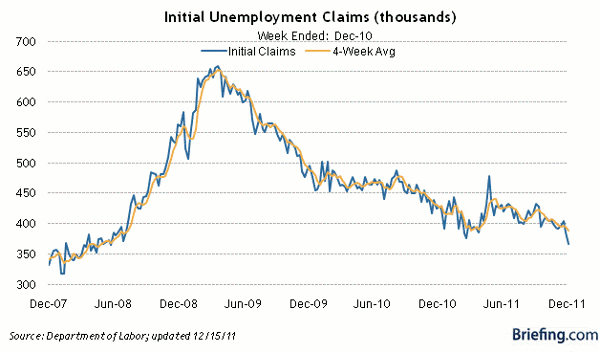Better growth in the US should help the Russell 2000 catch up to the larger-cap indices in the weeks ahead. Here’s a fund and a stock to play that hunch, writes MoneyShow.com senior editor Igor Greenwald.
If the US economy falls into a recession sometime next year as a result of the financial crisis in Europe and a slowdown in China, it won’t be for lack of effort.
Right now, it’s looking like the main global growth engine, and frankly the only reason the remaining stock investors have not to sell everything and hunker down under a mattress stuffed with cash.
Initial unemployment claims haven’t been this low in three years, fueling hopes that the job market has finally turned the corner.
Other economic indicators have also surprised to the upside recently. Consumers and industrial customers are hanging in there, and companies continue to invest in technology and other infrastructure. The real-estate market may take longer to bottom, but rising rental rates and the action in homebuilding stocks hint at improvement as early as this spring.
Perhaps America’s longstanding and recently underappreciated strengths are finally starting to show. Or maybe we’ve just underestimated what a federal budget deficit approaching 9% of GDP can do, over time.
The US economy’s relative outperformance while Europe flails and China slows has shifted the macroeconomic risk facing listed companies. Now the multinationals doing business in every corner of the world are exposed to the slowdown overseas, while smaller companies with greater exposure to the US market would seem to have home-field momentum on their side.
Because they generally do less business overseas, small-cap stocks are also less likely to lose profits and competitiveness should the dollar continue its recent rebound.
The benchmark small-cap index, the Russell 2000, was down 9% year-to-date through Thursday, significantly trailing the Dow Jones Industrial Average (up 2.5%) and the S&P 500 (down 3.3%).
Small caps still look more expensive than large-cap stocks based on trailing price-to-earnings: it’s 17 excluding losses for the Russell 2000, versus 12, losses included, for the S&P 500.
But they’re not so expensive based on the projected pace of earnings growth, notes money manager, author and former Merrill Lynch strategist Richard Bernstein, who calls US small caps “the best secular investment theme in the global equity markets” in his 2012 preview.
“Smaller US companies are starved for capital much the way that emerging markets, energy, and commodities were ten years ago,” Bernstein writes. “By definition, capital-starved companies’ higher cost of capital translates to higher expected returns for investors.”
And indeed, Russell 2000 stocks are expected to increase their earnings by a third next year, based on analysts’ estimates.
Come recession, all bets are obviously off. But if the US dodges the bullet, small caps do have significant potential to outperform. In the shorter term, they would benefit if the current risk-off mode gives way to risk-on in January, historically a good month for small-caps.
In that spirit, I have a good looking small-cap fund and a promising small-cap stock on my radar screen. The fund is the Invesco Small Companies A (ATIAX), rated five stars by Morningstar and handily beating its benchmarks and competitors this year, returning nearly 8% year-to-date versus a 4% loss on average for small-blend funds tracked by Morningstar.
Invesco’s portfolio is tilted toward technology and health care, and had a slightly lower P/E ratio than its benchmark. The minimum investment is $1,000; the expense ratio is 1.31%.
The stock that’s caught my fancy is Ebix (EBIX), a fast-growing supplier of specialty cloud-based software for the insurance industry, a space in which it is the leading vendor.
Ebix spent much of the year in investors’ doghouse after a blog questioned its accounting and history of acquisitions. Short interest in the name remains very high, at a whopping 38% of float as of the end of November.
But the controversy has done nothing to derail the company’s strong results and impressive growth trajectory. It retains the backing of Fidelity funds, which own more than 12% of outstanding shares, and of the crew over at Motley Fool, which continues to recommend the stock in its newsletters.
The dynamic and generally well regarded CEO owns another 11% of shares outstanding. He added to his stake in June. A key director bought nearly $500,000 of shares on the open market Monday, contributing to the stock’s rebound above its 200-day moving average.
Ebix has a forward P/E ratio of 12, is posting sales growth of 28%, and boasts a 40% profit margin. Despite an acquisitive streak that helped it enter markets such as India and Brazil, the company has spent $62.7 million on share buybacks this year—significant given that the current market cap is only $764 million.
While some 30% of the company’s revenue comes from overseas, nearly three-quarters of all sales is of the sticky “recurring” variety. Ebix gets paid for connecting insurers and brokers via specialized, cloud-based exchanges and other software services.
Its exchanges are said to process insurance transactions worth $100 billion annually. You can learn more about Ebix from this corporate summary.
Even if recession returns, the business should do OK. And if there are better times ahead, this stock could fly.
Related Reading:
3 Smaller Cap Names You Havent Heard4 Energy Plays That Dont Need an Army
4 Buys as We Repatriate Assets












